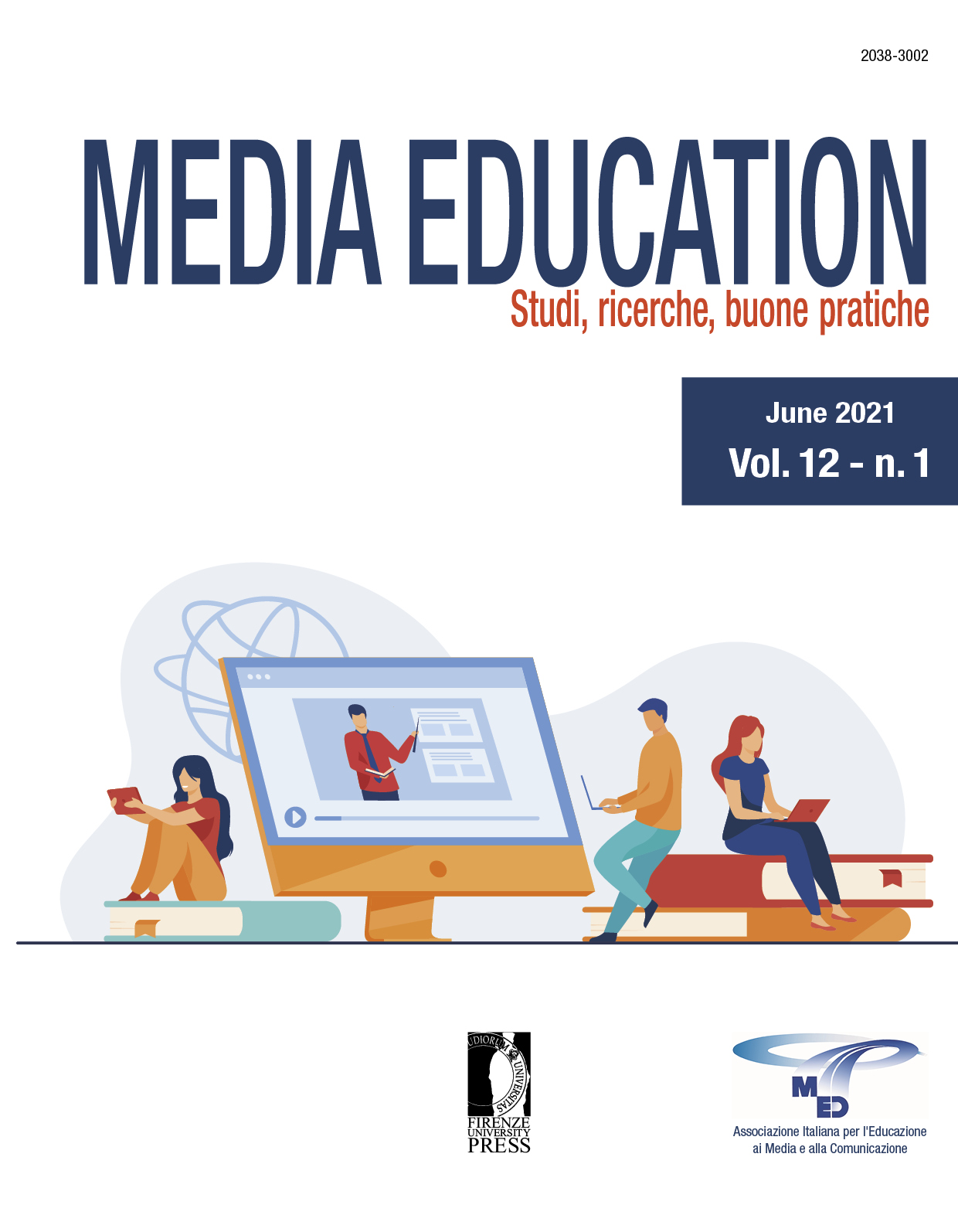Published 2021-05-03
Keywords
- storytelling,
- teenagers,
- digital skills,
- identity,
- social network
Abstract
In this paper, we investigate how young people use social media. In particular, we analyse their narrative strategies and what is considered crucial in others’ social representation. This research study was carried out in the high schools of Reggio Calabria, a provincial capital medium-sized in the south of Italy. Using a survey, we investigate the everyday uses of the Internet technologies by girls and boys aged between fourteen and sixteen: their performed activities, the smartphone role in their family and peers relationships, the impact of the digital content on their behaviours. According to our findings, dichotomy interpretations of the digital ecosystem turn out to be misleading: people live consistently within both environments of an existence on-life. In the conclusions, we claim that we should not stigmatise this double environment lives, but understand and give it value.
References
Balzola, A. (2020). L’educazione a distanza alla luce e all’ombra della pandemia. Mediascapes journal, 15, 203-210.
Boyd, D. (2014). It's complicated: The social lives of networked teens. Yale University Press.
Boyd, D. M., & Ellison, N. B. (2007). Social network sites: Definition, history, and scholarship. Journal of computer-mediated communication, 13 (1), 210-230. https://doi.org/10.1111/j.1083-6101.2007.00393.x
Biscaldi, A. & Matera, V. (2019). Antropologia dei social media. Comunicare nel mondo globale. Carocci.
Boccia Artieri, G., Gemini, L., Pasquali, F., Carlo, S., Farci, M., & Pedroni, M. (2017). Fenomenologia dei social network. presenza, relazioni e consumi mediali degli italiani online, Guerini.
Bruner, J. (1987). Life as narrative. Social research, 54 (1), 11-32.
Bruner, J. (1991). The narrative construction of reality. Critical inquiry, 18(1), 1-21.
Cappello, G. (2015). Ritorno al futuro. Miti e realtà dei nativi digitali. Aracne.
Castells, M. (2009). Comunicazione e potere. Università Bocconi Editore.
Castells, M. (1998). End of Millennium, The Information Age: Economy, Society and Culture, Vol. III. Blackwell.
Cava, A. (2020). Uno, nessuno, centomila Sé. Per una semiotica dell’identità. In M. R. Bartolomei (Ed.), La realtà manipolata. L’impatto delle nuove tecnologie sui sistemi individuali e collettivi di pensiero e di azione (pp. 18-35). L’Harmattan.
Cava, A. & Pira F. (2015). Social Gossip. Dalla chiacchiera di cortile al web pettegolezzo. Aracne.
Cometa, M. (2017). Perché le storie ci aiutano a vivere. Raffaello Cortina Editore.
Floridi, L. (2017). La quarta rivoluzione. Come l’infosfera sta cambiando il mondo. Raffaello Cortina.
Kraul R. et al. (1998). Internet Paradox: A Social Technology That Reduces Social Involvement and Psychological Well-Being?. American Psychologist, 53 (9), 1017-31. 10.1037//0003-066x.53.9.1017
Livingstone, S. ( 2009). Children and the Internet. Polity Press.
Livingstone, S. (2008). Taking Risky Opportunities in youthful content creation: teenagers' use of social networking sites for intimacy, privacy and self-expression. New Media & Society, 10 (3), 393-411. 10.1177/1461444808089415
Mortara, A. & Roberti, G. (2016). Da appassionato a testimonial: l’evoluzione del blogger. Micro & Macro Marketing, 75 (3), 397-410. 10.1431/84722
Moscovici, S. (2005). Le rappresentazioni sociali. Il Mulino.
Naas C. (2012). Is Facebook Stunting Your Child's Growth?. Pacific Standard, 23.
Nie H. N., Erbring L. (2002). Internet and Society: A Preliminary Report. Internet and Society, 1 (1), 275-283.
Papacharissi, Z. (2011). A Networked Self: Identity, Community and Culture on Social Network Sites. Routledge.
Pentecoste, N. (2013). Goffman Rewind: la presentazione del self nel quotidiano digitale. Mediascapes Journal, 2, 106-118.
Prensky, M. (2001). Digital Natives, Digital Immigrants. On the Horizon, 9 (5).
Rainie, L., & Wellman B. (2012). Networked: the New Social Operating System. The MIT Press.
Rheingold, D. (2013). Perché la rete ci rende intelligenti. Raffaello Cortina.
Riva, G. (2016). I social network. Il Mulino.
Robinson J. P. et al. (2002). The Internet and the Other Uses of time. In B. Wellman & C. Haythornthwaite (eds.), The Internet in Everyday Life (pp. 244-262). Blackwell.
Roversi, A. (2006). L’odio in rete. Siti ultras, nazifascismo online, jihad elettronica. Il Mulino.
Soavi, G. & Allegro, S. (2012). L’abuso sessuale online: tra prassi di intervento consolidate e nuove sfide. Maltrattamento e abuso all’infanzia, 14 (3), 7-16. https://doi.org/10.3280/MAL2012-003001
Stone, A. R. (1997). Desiderio e tecnologia. Il problema dell’identità nell’era di Internet. Feltrinelli.
Turkle, S. (2016). La conversazione necessaria. La forza del dialogo nell’era digitale. Einaudi.

